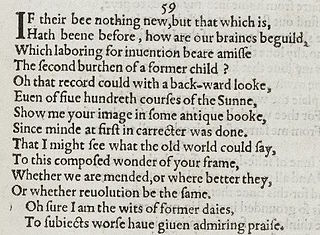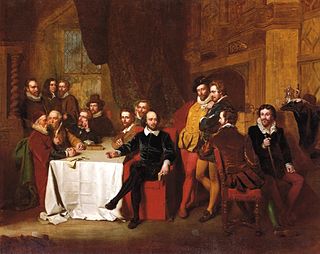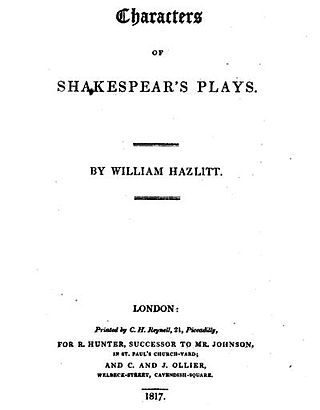
A sonnet is a poetic form that originated in the poetry composed at the Court of the Holy Roman Emperor Frederick II in the Sicilian city of Palermo. The 13th-century poet and notary Giacomo da Lentini is credited with the sonnet's invention, and the Sicilian School of poets who surrounded him then spread the form to the mainland. The earliest sonnets, however, no longer survive in the original Sicilian language, but only after being translated into Tuscan dialect.

William Shakespeare was an English playwright, poet, and actor. He is widely regarded as the greatest writer in the English language and the world's pre-eminent dramatist. He is often called England's national poet and the "Bard of Avon". His extant works, including collaborations, consist of some 39 plays, 154 sonnets, three long narrative poems, and a few other verses, some of uncertain authorship. His plays have been translated into every major living language and are performed more often than those of any other playwright. Shakespeare remains arguably the most influential writer in the English language, and his works continue to be studied and reinterpreted.

Samuel Daniel (1562–1619) was an English poet, playwright and historian in the late-Elizabethan and early-Jacobean eras. He was an innovator in a wide range of literary genres. His best-known works are the sonnet cycle Delia, the epic poem The Civil Wars Between the Houses of Lancaster and York, the dialogue in verse Musophilus, and the essay on English poetry A Defence of Rhyme. He was considered one of the preeminent authors of his time and his works had a significant influence on contemporary writers, including William Shakespeare. Daniel's writings continued to influence authors for centuries after his death, especially the Romantic poets Samuel Taylor Coleridge and William Wordsworth. C. S. Lewis called Daniel "the most interesting man of letters" whom the sixteenth century produced in England.

Blank verse is poetry written with regular metrical but unrhymed lines, usually in iambic pentameter. It has been described as "probably the most common and influential form that English poetry has taken since the 16th century", and Paul Fussell has estimated that "about three quarters of all English poetry is in blank verse".
Songes and Sonettes, usually called Tottel's Miscellany, was the first printed anthology of English poetry. First published by Richard Tottel in 1557 in London, it ran to many editions in the sixteenth century.
Stephen Booth was a professor of English literature at the University of California, Berkeley. He was a leading Shakespearean scholar.

Elizabethan literature refers to bodies of work produced during the reign of Queen Elizabeth I (1558–1603), and is one of the most splendid ages of English literature. In addition to drama and the theatre, it saw a flowering of poetry, with new forms like the sonnet, the Spenserian stanza, and dramatic blank verse, as well as prose, including historical chronicles, pamphlets, and the first English novels. Major writers include William Shakespeare, Edmund Spenser, Christopher Marlowe, Richard Hooker, Ben Jonson, Philip Sidney and Thomas Kyd.

In Shakespearean scholarship, the Henriad refers to a group of William Shakespeare's history plays depicting the rise of the English kings. It is sometimes used to refer to a group of four plays, but some sources and scholars use the term to refer to eight plays. In the 19th century, Algernon Charles Swinburne used the term to refer to three plays, but that use is not current.

Shakespeare's plays are a canon of approximately 39 dramatic works written by the English poet, playwright, and actor William Shakespeare. The exact number of plays as well as their classifications as tragedy, history, comedy, or otherwise is a matter of scholarly debate. Shakespeare's plays are widely regarded as among the greatest in the English language and are continually performed around the world. The plays have been translated into every major living language.

This glossary of literary terms is a list of definitions of terms and concepts used in the discussion, classification, analysis, and criticism of all types of literature, such as poetry, novels, and picture books, as well as of grammar, syntax, and language techniques. For a more complete glossary of terms relating to poetry in particular, see Glossary of poetry terms.
John Kerrigan, is a British literary scholar, with interests including the works of Shakespeare, Wordsworth and modern poetry since Emily Dickinson and Hopkins, along with Irish studies.

Sonnet 23 is one of a sequence of 154 sonnets written by the English playwright and poet William Shakespeare, and is a part of the Fair Youth sequence.

Sonnet 59 is one of 154 sonnets written by the English playwright and poet William Shakespeare. It's a part of the Fair Youth sequence, in which the poet expresses his love towards a young man.
Sonnet 125 is one of 154 sonnets written by the English playwright and poet William Shakespeare. It is a member of the Fair Youth sequence, in which the poet expresses his love towards a young man.

William Shakespeare's style of writing was borrowed from the conventions of the day and adapted to his needs.

Sonnet 86 is one of 154 sonnets first published by the English playwright and poet William Shakespeare in the Quarto of 1609. It is the final poem of the Rival Poet group of the Fair Youth sonnets in which Shakespeare writes about an unnamed young man and a rival poet competing for the youth's favor. Though the exact date of its composition is unknown, it has been suggested that the Rival Poet series may have been written between 1598 and 1600.
Decasyllabic quatrain is a poetic form in which each stanza consists of four lines of ten syllables each, usually with a rhyme scheme of AABB or ABAB. Examples of the decasyllabic quatrain in heroic couplets appear in some of the earliest texts in the English language, as Geoffrey Chaucer created the heroic couplet and used it in The Canterbury Tales. The alternating form came to prominence in late 16th-century English poetry and became fashionable in the 17th century when it appeared in heroic poems by William Davenant and John Dryden. In the 18th century famous poets such as Thomas Gray continued to use the form in works such as "Elegy Written in a Country Churchyard". Shakespearean Sonnets, comprising 3 quatrains of iambic pentameter followed by a final couplet, as well as later poems in blank verse have displayed the various uses of the decasyllabic quatrain throughout the history of English Poetry.

Characters of Shakespear's Plays is an 1817 book of criticism of Shakespeare's plays, written by early nineteenth century English essayist and literary critic William Hazlitt. Composed in reaction to the neoclassical approach to Shakespeare's plays typified by Samuel Johnson, it was among the first English-language studies of Shakespeare's plays to follow the manner of German critic August Wilhelm Schlegel, and, with the work of Samuel Taylor Coleridge, paved the way for the increased appreciation of Shakespeare's genius that was characteristic of later nineteenth-century criticism. It was also the first book to cover all of Shakespeare's plays, intended as a guide for the general reader.

The following outline is provided as an overview of and topical guide to the life and legacy of William Shakespeare, an English poet, playwright, and actor who lived during the 17th century. He is widely regarded as the greatest writer in the English language and the world's pre-eminent dramatist. He is often called England's national poet and the "Bard of Avon".
According to Dr. Naseeb Shaheen, Shakespeare, in writing his plays, "seldom borrows biblical references from his sources, even when those sources contain many references." Roy Battenhouse notes that the Shakespearean tragedy "frequently echoes Bible language or paradigm, even when the play's setting is pagan." Similarly, Peter Milward notes that despite their secular appearance, Shakespeare's plays "conceal an undercurrent of religious meaning which belongs to their deepest essence." Further, Milward maintains that although Shakespeare "may have felt obliged by the circumstances of the Elizabethan stage to avoid Biblical or other religious subjects for his plays," such obligation "did not prevent him from making full use of the Bible in dramatizing his secular sources and thus infusing into them a Biblical meaning." Milward continues that, in writing his plays, Shakespeare "shows the universal relevance of the Bible both to the reality of human life 'in this harsh world' and to its ideal in the heart of God." Steven Marx suggests "a thorough familiarity with the Scriptures" is a prerequisite to understanding the Biblical references in the plays, and that the plays' references to the Bible "illuminate fresh and surprising meanings in the biblical text." Marx further notes that "it is possible that Shakespeare sometimes regarded his own role of playwright and performer as godlike, his own book as potent and capacious as 'The Book'." It is important to note, as a recent study points out “The diversity of versions reflected in Shakespeare’s writing indicates that ‘Shakespeare’s Bible’ cannot be taken for granted as unitary, since it consists of a network of different translations”














